Communicating and Working with Others
VerifiedAdded on 2023/06/07
|14
|3371
|151
AI Summary
Successful teaching of students with special needs requires the collaboration of professionals. This article discusses the factors that influence an effective collaborative relationship in teaching students living with disabilities and other special needs. It also provides an action plan to develop proactive skills in solving problems and effective communication skills to create an understanding relationship with colleagues and students with special needs.
Contribute Materials
Your contribution can guide someone’s learning journey. Share your
documents today.
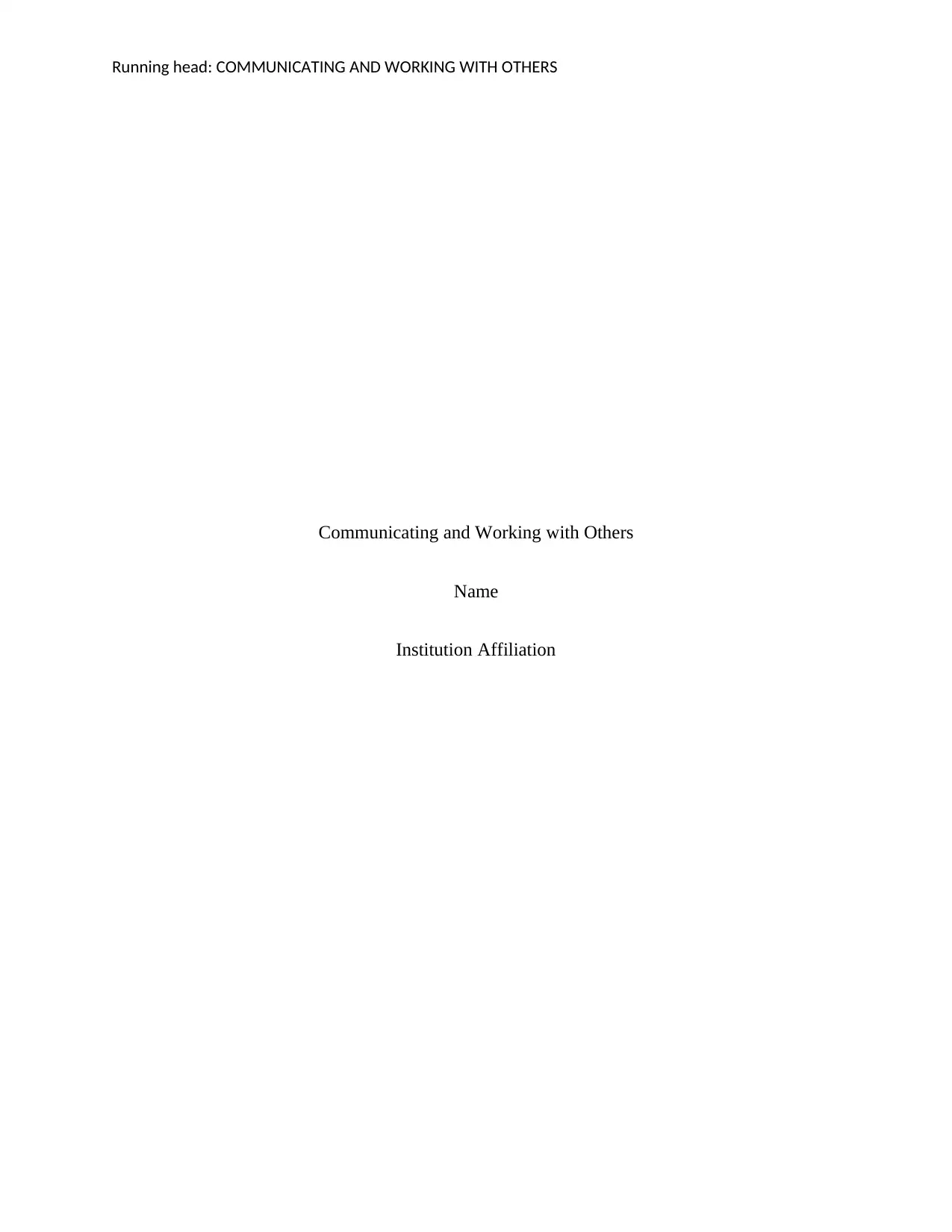
Running head: COMMUNICATING AND WORKING WITH OTHERS
Communicating and Working with Others
Name
Institution Affiliation
Communicating and Working with Others
Name
Institution Affiliation
Secure Best Marks with AI Grader
Need help grading? Try our AI Grader for instant feedback on your assignments.
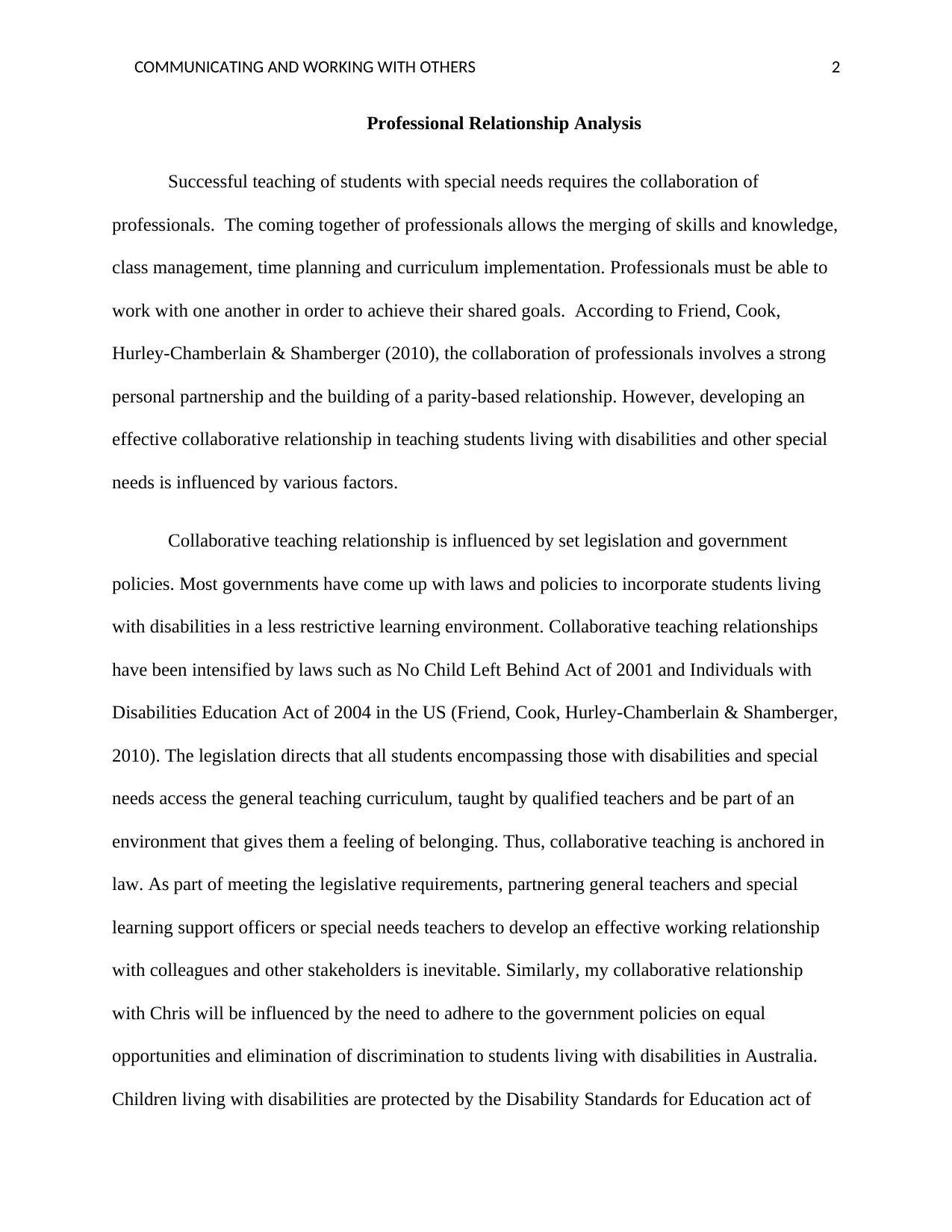
COMMUNICATING AND WORKING WITH OTHERS 2
Professional Relationship Analysis
Successful teaching of students with special needs requires the collaboration of
professionals. The coming together of professionals allows the merging of skills and knowledge,
class management, time planning and curriculum implementation. Professionals must be able to
work with one another in order to achieve their shared goals. According to Friend, Cook,
Hurley-Chamberlain & Shamberger (2010), the collaboration of professionals involves a strong
personal partnership and the building of a parity-based relationship. However, developing an
effective collaborative relationship in teaching students living with disabilities and other special
needs is influenced by various factors.
Collaborative teaching relationship is influenced by set legislation and government
policies. Most governments have come up with laws and policies to incorporate students living
with disabilities in a less restrictive learning environment. Collaborative teaching relationships
have been intensified by laws such as No Child Left Behind Act of 2001 and Individuals with
Disabilities Education Act of 2004 in the US (Friend, Cook, Hurley-Chamberlain & Shamberger,
2010). The legislation directs that all students encompassing those with disabilities and special
needs access the general teaching curriculum, taught by qualified teachers and be part of an
environment that gives them a feeling of belonging. Thus, collaborative teaching is anchored in
law. As part of meeting the legislative requirements, partnering general teachers and special
learning support officers or special needs teachers to develop an effective working relationship
with colleagues and other stakeholders is inevitable. Similarly, my collaborative relationship
with Chris will be influenced by the need to adhere to the government policies on equal
opportunities and elimination of discrimination to students living with disabilities in Australia.
Children living with disabilities are protected by the Disability Standards for Education act of
Professional Relationship Analysis
Successful teaching of students with special needs requires the collaboration of
professionals. The coming together of professionals allows the merging of skills and knowledge,
class management, time planning and curriculum implementation. Professionals must be able to
work with one another in order to achieve their shared goals. According to Friend, Cook,
Hurley-Chamberlain & Shamberger (2010), the collaboration of professionals involves a strong
personal partnership and the building of a parity-based relationship. However, developing an
effective collaborative relationship in teaching students living with disabilities and other special
needs is influenced by various factors.
Collaborative teaching relationship is influenced by set legislation and government
policies. Most governments have come up with laws and policies to incorporate students living
with disabilities in a less restrictive learning environment. Collaborative teaching relationships
have been intensified by laws such as No Child Left Behind Act of 2001 and Individuals with
Disabilities Education Act of 2004 in the US (Friend, Cook, Hurley-Chamberlain & Shamberger,
2010). The legislation directs that all students encompassing those with disabilities and special
needs access the general teaching curriculum, taught by qualified teachers and be part of an
environment that gives them a feeling of belonging. Thus, collaborative teaching is anchored in
law. As part of meeting the legislative requirements, partnering general teachers and special
learning support officers or special needs teachers to develop an effective working relationship
with colleagues and other stakeholders is inevitable. Similarly, my collaborative relationship
with Chris will be influenced by the need to adhere to the government policies on equal
opportunities and elimination of discrimination to students living with disabilities in Australia.
Children living with disabilities are protected by the Disability Standards for Education act of
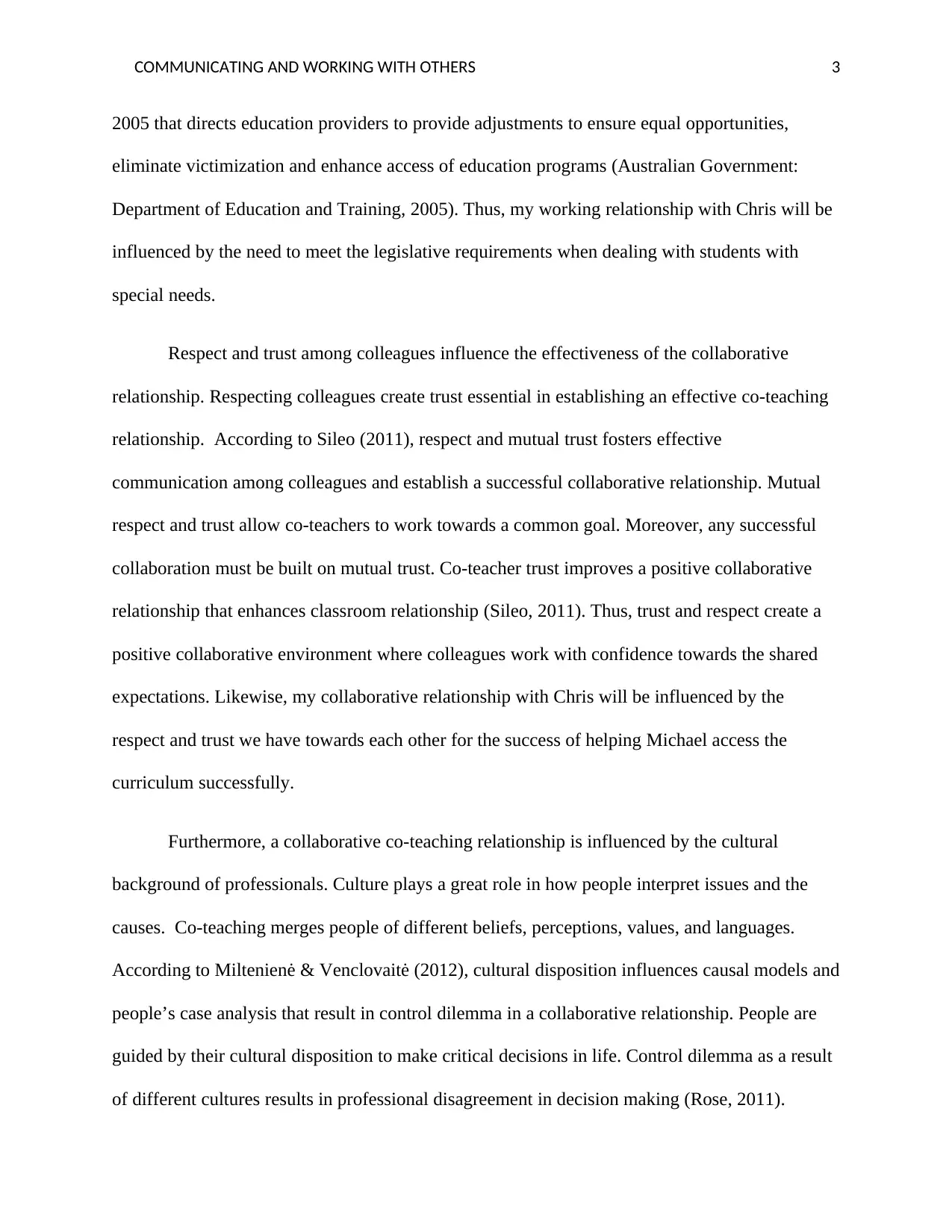
COMMUNICATING AND WORKING WITH OTHERS 3
2005 that directs education providers to provide adjustments to ensure equal opportunities,
eliminate victimization and enhance access of education programs (Australian Government:
Department of Education and Training, 2005). Thus, my working relationship with Chris will be
influenced by the need to meet the legislative requirements when dealing with students with
special needs.
Respect and trust among colleagues influence the effectiveness of the collaborative
relationship. Respecting colleagues create trust essential in establishing an effective co-teaching
relationship. According to Sileo (2011), respect and mutual trust fosters effective
communication among colleagues and establish a successful collaborative relationship. Mutual
respect and trust allow co-teachers to work towards a common goal. Moreover, any successful
collaboration must be built on mutual trust. Co-teacher trust improves a positive collaborative
relationship that enhances classroom relationship (Sileo, 2011). Thus, trust and respect create a
positive collaborative environment where colleagues work with confidence towards the shared
expectations. Likewise, my collaborative relationship with Chris will be influenced by the
respect and trust we have towards each other for the success of helping Michael access the
curriculum successfully.
Furthermore, a collaborative co-teaching relationship is influenced by the cultural
background of professionals. Culture plays a great role in how people interpret issues and the
causes. Co-teaching merges people of different beliefs, perceptions, values, and languages.
According to Miltenienė & Venclovaitė (2012), cultural disposition influences causal models and
people’s case analysis that result in control dilemma in a collaborative relationship. People are
guided by their cultural disposition to make critical decisions in life. Control dilemma as a result
of different cultures results in professional disagreement in decision making (Rose, 2011).
2005 that directs education providers to provide adjustments to ensure equal opportunities,
eliminate victimization and enhance access of education programs (Australian Government:
Department of Education and Training, 2005). Thus, my working relationship with Chris will be
influenced by the need to meet the legislative requirements when dealing with students with
special needs.
Respect and trust among colleagues influence the effectiveness of the collaborative
relationship. Respecting colleagues create trust essential in establishing an effective co-teaching
relationship. According to Sileo (2011), respect and mutual trust fosters effective
communication among colleagues and establish a successful collaborative relationship. Mutual
respect and trust allow co-teachers to work towards a common goal. Moreover, any successful
collaboration must be built on mutual trust. Co-teacher trust improves a positive collaborative
relationship that enhances classroom relationship (Sileo, 2011). Thus, trust and respect create a
positive collaborative environment where colleagues work with confidence towards the shared
expectations. Likewise, my collaborative relationship with Chris will be influenced by the
respect and trust we have towards each other for the success of helping Michael access the
curriculum successfully.
Furthermore, a collaborative co-teaching relationship is influenced by the cultural
background of professionals. Culture plays a great role in how people interpret issues and the
causes. Co-teaching merges people of different beliefs, perceptions, values, and languages.
According to Miltenienė & Venclovaitė (2012), cultural disposition influences causal models and
people’s case analysis that result in control dilemma in a collaborative relationship. People are
guided by their cultural disposition to make critical decisions in life. Control dilemma as a result
of different cultures results in professional disagreement in decision making (Rose, 2011).
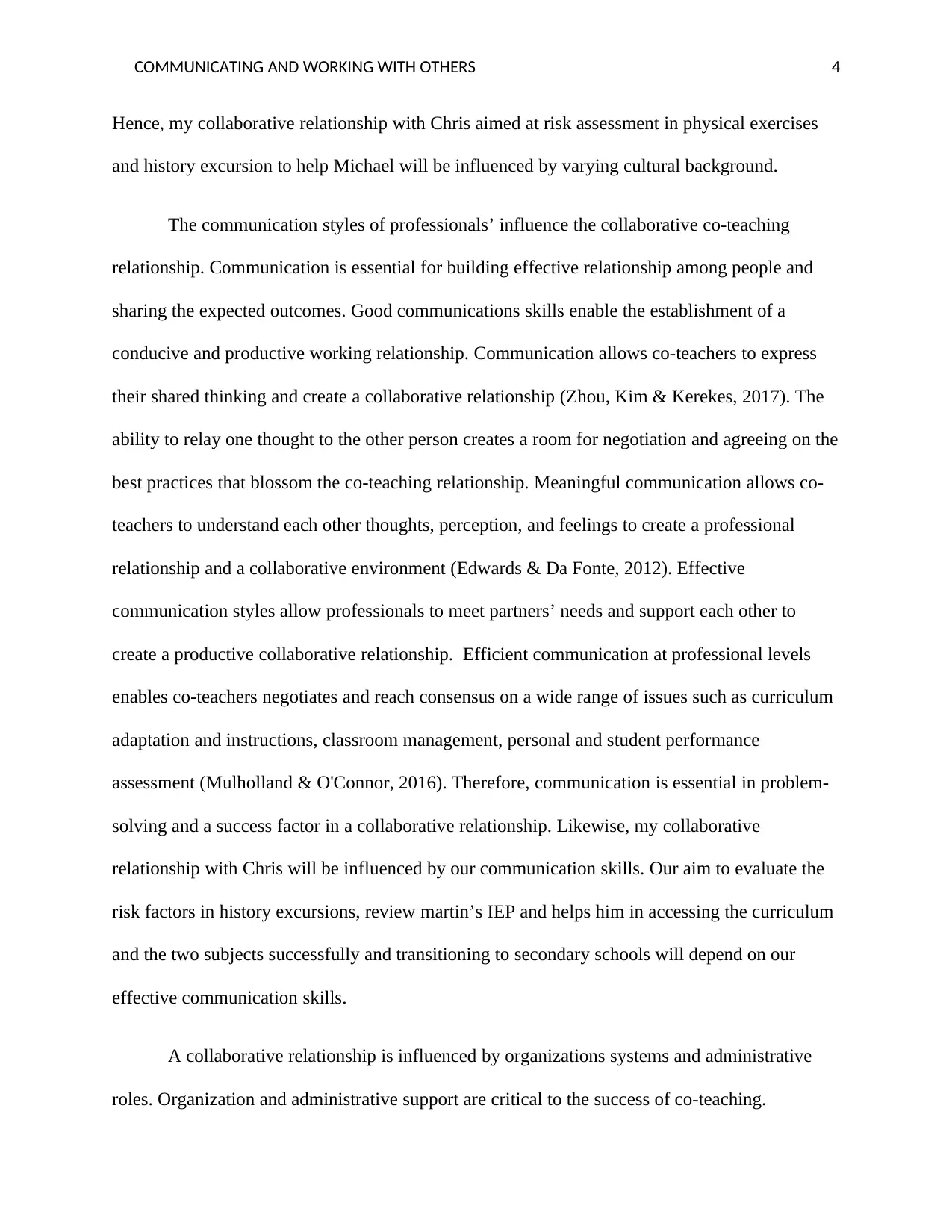
COMMUNICATING AND WORKING WITH OTHERS 4
Hence, my collaborative relationship with Chris aimed at risk assessment in physical exercises
and history excursion to help Michael will be influenced by varying cultural background.
The communication styles of professionals’ influence the collaborative co-teaching
relationship. Communication is essential for building effective relationship among people and
sharing the expected outcomes. Good communications skills enable the establishment of a
conducive and productive working relationship. Communication allows co-teachers to express
their shared thinking and create a collaborative relationship (Zhou, Kim & Kerekes, 2017). The
ability to relay one thought to the other person creates a room for negotiation and agreeing on the
best practices that blossom the co-teaching relationship. Meaningful communication allows co-
teachers to understand each other thoughts, perception, and feelings to create a professional
relationship and a collaborative environment (Edwards & Da Fonte, 2012). Effective
communication styles allow professionals to meet partners’ needs and support each other to
create a productive collaborative relationship. Efficient communication at professional levels
enables co-teachers negotiates and reach consensus on a wide range of issues such as curriculum
adaptation and instructions, classroom management, personal and student performance
assessment (Mulholland & O'Connor, 2016). Therefore, communication is essential in problem-
solving and a success factor in a collaborative relationship. Likewise, my collaborative
relationship with Chris will be influenced by our communication skills. Our aim to evaluate the
risk factors in history excursions, review martin’s IEP and helps him in accessing the curriculum
and the two subjects successfully and transitioning to secondary schools will depend on our
effective communication skills.
A collaborative relationship is influenced by organizations systems and administrative
roles. Organization and administrative support are critical to the success of co-teaching.
Hence, my collaborative relationship with Chris aimed at risk assessment in physical exercises
and history excursion to help Michael will be influenced by varying cultural background.
The communication styles of professionals’ influence the collaborative co-teaching
relationship. Communication is essential for building effective relationship among people and
sharing the expected outcomes. Good communications skills enable the establishment of a
conducive and productive working relationship. Communication allows co-teachers to express
their shared thinking and create a collaborative relationship (Zhou, Kim & Kerekes, 2017). The
ability to relay one thought to the other person creates a room for negotiation and agreeing on the
best practices that blossom the co-teaching relationship. Meaningful communication allows co-
teachers to understand each other thoughts, perception, and feelings to create a professional
relationship and a collaborative environment (Edwards & Da Fonte, 2012). Effective
communication styles allow professionals to meet partners’ needs and support each other to
create a productive collaborative relationship. Efficient communication at professional levels
enables co-teachers negotiates and reach consensus on a wide range of issues such as curriculum
adaptation and instructions, classroom management, personal and student performance
assessment (Mulholland & O'Connor, 2016). Therefore, communication is essential in problem-
solving and a success factor in a collaborative relationship. Likewise, my collaborative
relationship with Chris will be influenced by our communication skills. Our aim to evaluate the
risk factors in history excursions, review martin’s IEP and helps him in accessing the curriculum
and the two subjects successfully and transitioning to secondary schools will depend on our
effective communication skills.
A collaborative relationship is influenced by organizations systems and administrative
roles. Organization and administrative support are critical to the success of co-teaching.
Secure Best Marks with AI Grader
Need help grading? Try our AI Grader for instant feedback on your assignments.
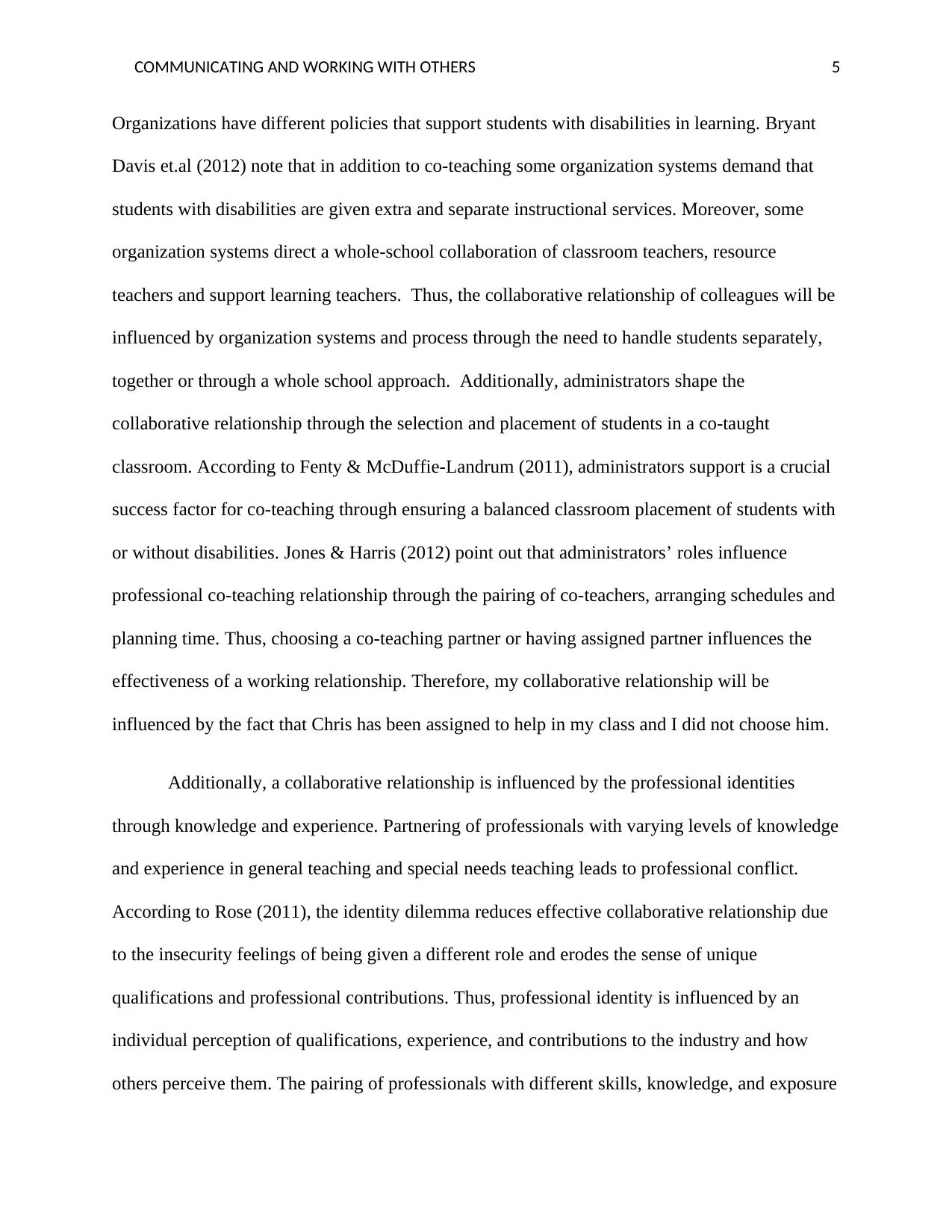
COMMUNICATING AND WORKING WITH OTHERS 5
Organizations have different policies that support students with disabilities in learning. Bryant
Davis et.al (2012) note that in addition to co-teaching some organization systems demand that
students with disabilities are given extra and separate instructional services. Moreover, some
organization systems direct a whole-school collaboration of classroom teachers, resource
teachers and support learning teachers. Thus, the collaborative relationship of colleagues will be
influenced by organization systems and process through the need to handle students separately,
together or through a whole school approach. Additionally, administrators shape the
collaborative relationship through the selection and placement of students in a co-taught
classroom. According to Fenty & McDuffie-Landrum (2011), administrators support is a crucial
success factor for co-teaching through ensuring a balanced classroom placement of students with
or without disabilities. Jones & Harris (2012) point out that administrators’ roles influence
professional co-teaching relationship through the pairing of co-teachers, arranging schedules and
planning time. Thus, choosing a co-teaching partner or having assigned partner influences the
effectiveness of a working relationship. Therefore, my collaborative relationship will be
influenced by the fact that Chris has been assigned to help in my class and I did not choose him.
Additionally, a collaborative relationship is influenced by the professional identities
through knowledge and experience. Partnering of professionals with varying levels of knowledge
and experience in general teaching and special needs teaching leads to professional conflict.
According to Rose (2011), the identity dilemma reduces effective collaborative relationship due
to the insecurity feelings of being given a different role and erodes the sense of unique
qualifications and professional contributions. Thus, professional identity is influenced by an
individual perception of qualifications, experience, and contributions to the industry and how
others perceive them. The pairing of professionals with different skills, knowledge, and exposure
Organizations have different policies that support students with disabilities in learning. Bryant
Davis et.al (2012) note that in addition to co-teaching some organization systems demand that
students with disabilities are given extra and separate instructional services. Moreover, some
organization systems direct a whole-school collaboration of classroom teachers, resource
teachers and support learning teachers. Thus, the collaborative relationship of colleagues will be
influenced by organization systems and process through the need to handle students separately,
together or through a whole school approach. Additionally, administrators shape the
collaborative relationship through the selection and placement of students in a co-taught
classroom. According to Fenty & McDuffie-Landrum (2011), administrators support is a crucial
success factor for co-teaching through ensuring a balanced classroom placement of students with
or without disabilities. Jones & Harris (2012) point out that administrators’ roles influence
professional co-teaching relationship through the pairing of co-teachers, arranging schedules and
planning time. Thus, choosing a co-teaching partner or having assigned partner influences the
effectiveness of a working relationship. Therefore, my collaborative relationship will be
influenced by the fact that Chris has been assigned to help in my class and I did not choose him.
Additionally, a collaborative relationship is influenced by the professional identities
through knowledge and experience. Partnering of professionals with varying levels of knowledge
and experience in general teaching and special needs teaching leads to professional conflict.
According to Rose (2011), the identity dilemma reduces effective collaborative relationship due
to the insecurity feelings of being given a different role and erodes the sense of unique
qualifications and professional contributions. Thus, professional identity is influenced by an
individual perception of qualifications, experience, and contributions to the industry and how
others perceive them. The pairing of professionals with different skills, knowledge, and exposure
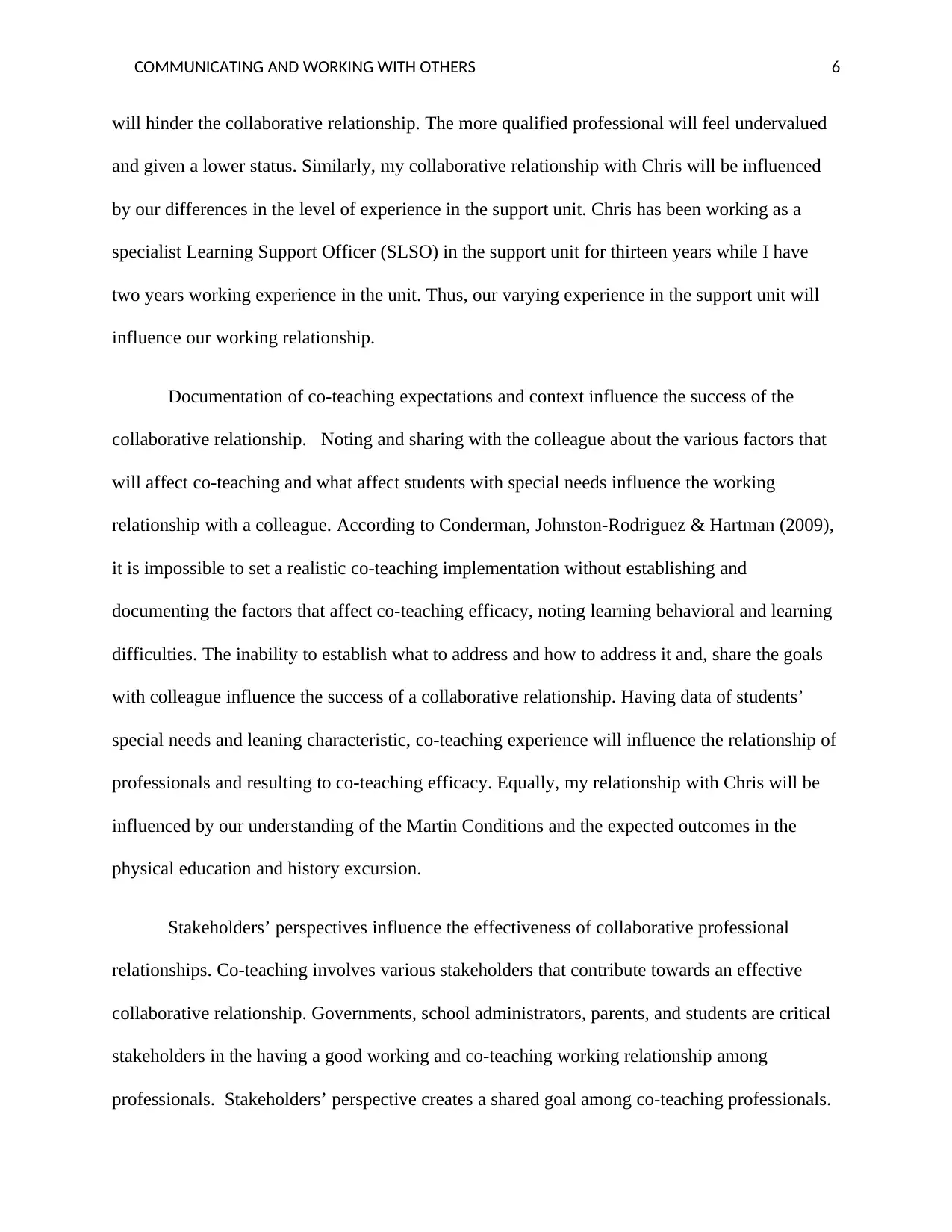
COMMUNICATING AND WORKING WITH OTHERS 6
will hinder the collaborative relationship. The more qualified professional will feel undervalued
and given a lower status. Similarly, my collaborative relationship with Chris will be influenced
by our differences in the level of experience in the support unit. Chris has been working as a
specialist Learning Support Officer (SLSO) in the support unit for thirteen years while I have
two years working experience in the unit. Thus, our varying experience in the support unit will
influence our working relationship.
Documentation of co-teaching expectations and context influence the success of the
collaborative relationship. Noting and sharing with the colleague about the various factors that
will affect co-teaching and what affect students with special needs influence the working
relationship with a colleague. According to Conderman, Johnston-Rodriguez & Hartman (2009),
it is impossible to set a realistic co-teaching implementation without establishing and
documenting the factors that affect co-teaching efficacy, noting learning behavioral and learning
difficulties. The inability to establish what to address and how to address it and, share the goals
with colleague influence the success of a collaborative relationship. Having data of students’
special needs and leaning characteristic, co-teaching experience will influence the relationship of
professionals and resulting to co-teaching efficacy. Equally, my relationship with Chris will be
influenced by our understanding of the Martin Conditions and the expected outcomes in the
physical education and history excursion.
Stakeholders’ perspectives influence the effectiveness of collaborative professional
relationships. Co-teaching involves various stakeholders that contribute towards an effective
collaborative relationship. Governments, school administrators, parents, and students are critical
stakeholders in the having a good working and co-teaching working relationship among
professionals. Stakeholders’ perspective creates a shared goal among co-teaching professionals.
will hinder the collaborative relationship. The more qualified professional will feel undervalued
and given a lower status. Similarly, my collaborative relationship with Chris will be influenced
by our differences in the level of experience in the support unit. Chris has been working as a
specialist Learning Support Officer (SLSO) in the support unit for thirteen years while I have
two years working experience in the unit. Thus, our varying experience in the support unit will
influence our working relationship.
Documentation of co-teaching expectations and context influence the success of the
collaborative relationship. Noting and sharing with the colleague about the various factors that
will affect co-teaching and what affect students with special needs influence the working
relationship with a colleague. According to Conderman, Johnston-Rodriguez & Hartman (2009),
it is impossible to set a realistic co-teaching implementation without establishing and
documenting the factors that affect co-teaching efficacy, noting learning behavioral and learning
difficulties. The inability to establish what to address and how to address it and, share the goals
with colleague influence the success of a collaborative relationship. Having data of students’
special needs and leaning characteristic, co-teaching experience will influence the relationship of
professionals and resulting to co-teaching efficacy. Equally, my relationship with Chris will be
influenced by our understanding of the Martin Conditions and the expected outcomes in the
physical education and history excursion.
Stakeholders’ perspectives influence the effectiveness of collaborative professional
relationships. Co-teaching involves various stakeholders that contribute towards an effective
collaborative relationship. Governments, school administrators, parents, and students are critical
stakeholders in the having a good working and co-teaching working relationship among
professionals. Stakeholders’ perspective creates a shared goal among co-teaching professionals.
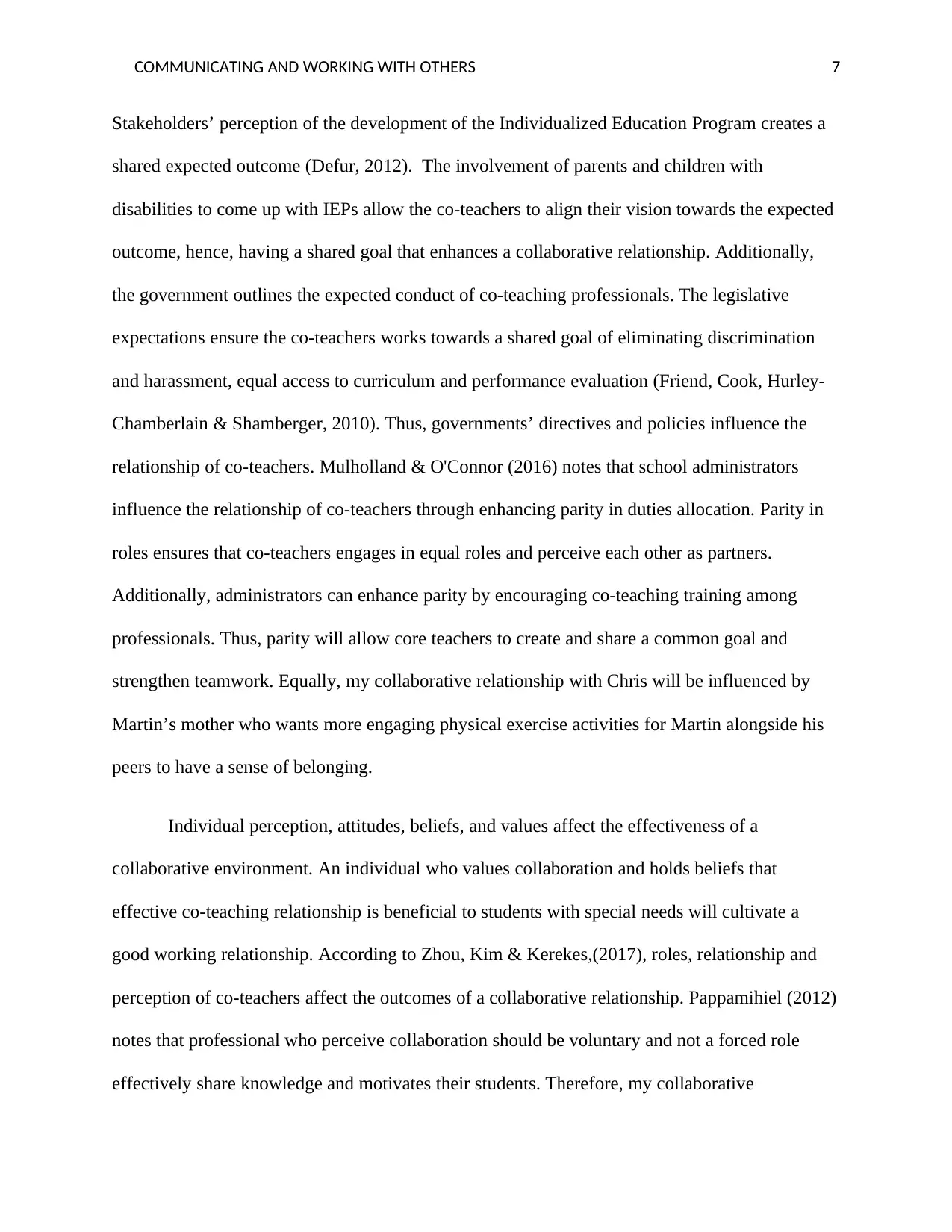
COMMUNICATING AND WORKING WITH OTHERS 7
Stakeholders’ perception of the development of the Individualized Education Program creates a
shared expected outcome (Defur, 2012). The involvement of parents and children with
disabilities to come up with IEPs allow the co-teachers to align their vision towards the expected
outcome, hence, having a shared goal that enhances a collaborative relationship. Additionally,
the government outlines the expected conduct of co-teaching professionals. The legislative
expectations ensure the co-teachers works towards a shared goal of eliminating discrimination
and harassment, equal access to curriculum and performance evaluation (Friend, Cook, Hurley-
Chamberlain & Shamberger, 2010). Thus, governments’ directives and policies influence the
relationship of co-teachers. Mulholland & O'Connor (2016) notes that school administrators
influence the relationship of co-teachers through enhancing parity in duties allocation. Parity in
roles ensures that co-teachers engages in equal roles and perceive each other as partners.
Additionally, administrators can enhance parity by encouraging co-teaching training among
professionals. Thus, parity will allow core teachers to create and share a common goal and
strengthen teamwork. Equally, my collaborative relationship with Chris will be influenced by
Martin’s mother who wants more engaging physical exercise activities for Martin alongside his
peers to have a sense of belonging.
Individual perception, attitudes, beliefs, and values affect the effectiveness of a
collaborative environment. An individual who values collaboration and holds beliefs that
effective co-teaching relationship is beneficial to students with special needs will cultivate a
good working relationship. According to Zhou, Kim & Kerekes,(2017), roles, relationship and
perception of co-teachers affect the outcomes of a collaborative relationship. Pappamihiel (2012)
notes that professional who perceive collaboration should be voluntary and not a forced role
effectively share knowledge and motivates their students. Therefore, my collaborative
Stakeholders’ perception of the development of the Individualized Education Program creates a
shared expected outcome (Defur, 2012). The involvement of parents and children with
disabilities to come up with IEPs allow the co-teachers to align their vision towards the expected
outcome, hence, having a shared goal that enhances a collaborative relationship. Additionally,
the government outlines the expected conduct of co-teaching professionals. The legislative
expectations ensure the co-teachers works towards a shared goal of eliminating discrimination
and harassment, equal access to curriculum and performance evaluation (Friend, Cook, Hurley-
Chamberlain & Shamberger, 2010). Thus, governments’ directives and policies influence the
relationship of co-teachers. Mulholland & O'Connor (2016) notes that school administrators
influence the relationship of co-teachers through enhancing parity in duties allocation. Parity in
roles ensures that co-teachers engages in equal roles and perceive each other as partners.
Additionally, administrators can enhance parity by encouraging co-teaching training among
professionals. Thus, parity will allow core teachers to create and share a common goal and
strengthen teamwork. Equally, my collaborative relationship with Chris will be influenced by
Martin’s mother who wants more engaging physical exercise activities for Martin alongside his
peers to have a sense of belonging.
Individual perception, attitudes, beliefs, and values affect the effectiveness of a
collaborative environment. An individual who values collaboration and holds beliefs that
effective co-teaching relationship is beneficial to students with special needs will cultivate a
good working relationship. According to Zhou, Kim & Kerekes,(2017), roles, relationship and
perception of co-teachers affect the outcomes of a collaborative relationship. Pappamihiel (2012)
notes that professional who perceive collaboration should be voluntary and not a forced role
effectively share knowledge and motivates their students. Therefore, my collaborative
Paraphrase This Document
Need a fresh take? Get an instant paraphrase of this document with our AI Paraphraser
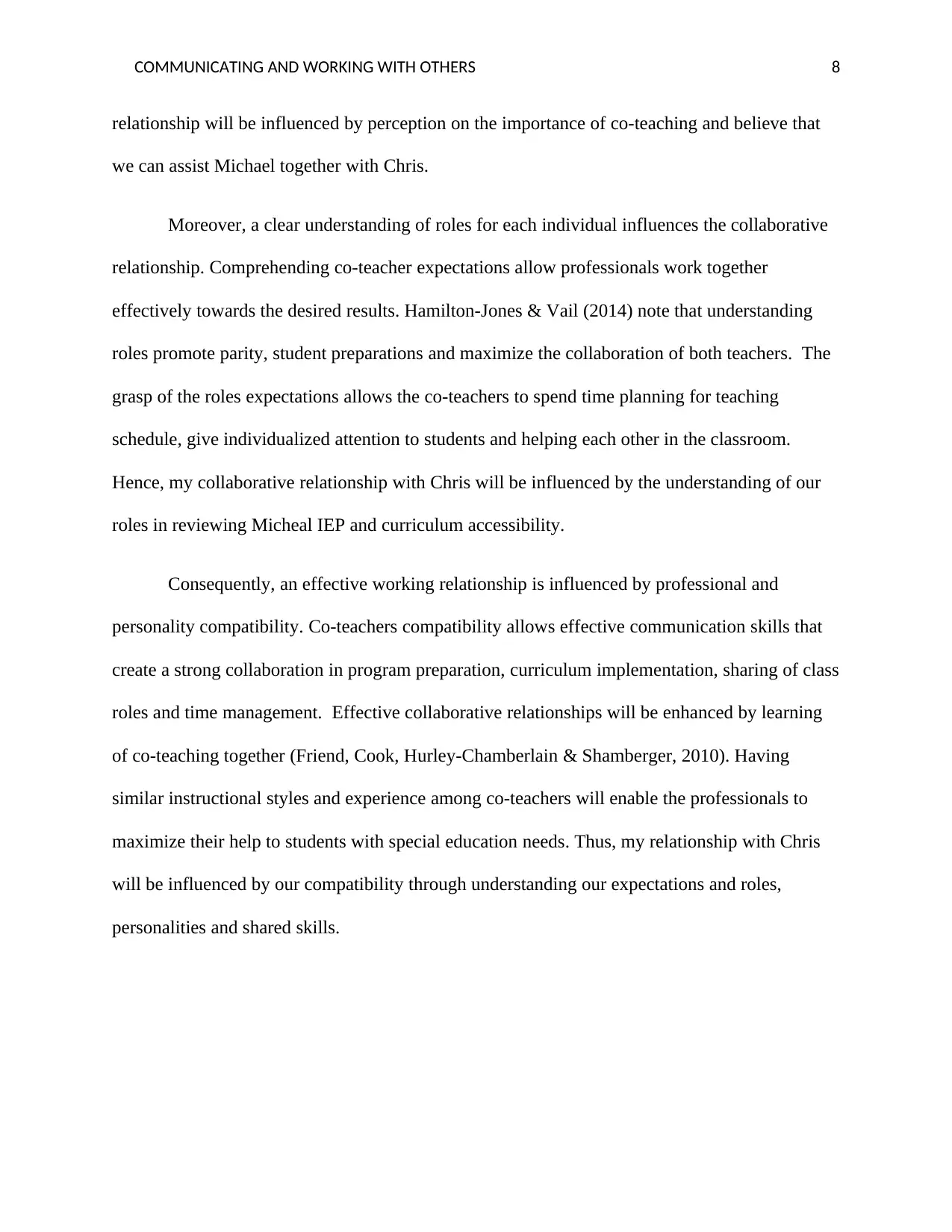
COMMUNICATING AND WORKING WITH OTHERS 8
relationship will be influenced by perception on the importance of co-teaching and believe that
we can assist Michael together with Chris.
Moreover, a clear understanding of roles for each individual influences the collaborative
relationship. Comprehending co-teacher expectations allow professionals work together
effectively towards the desired results. Hamilton-Jones & Vail (2014) note that understanding
roles promote parity, student preparations and maximize the collaboration of both teachers. The
grasp of the roles expectations allows the co-teachers to spend time planning for teaching
schedule, give individualized attention to students and helping each other in the classroom.
Hence, my collaborative relationship with Chris will be influenced by the understanding of our
roles in reviewing Micheal IEP and curriculum accessibility.
Consequently, an effective working relationship is influenced by professional and
personality compatibility. Co-teachers compatibility allows effective communication skills that
create a strong collaboration in program preparation, curriculum implementation, sharing of class
roles and time management. Effective collaborative relationships will be enhanced by learning
of co-teaching together (Friend, Cook, Hurley-Chamberlain & Shamberger, 2010). Having
similar instructional styles and experience among co-teachers will enable the professionals to
maximize their help to students with special education needs. Thus, my relationship with Chris
will be influenced by our compatibility through understanding our expectations and roles,
personalities and shared skills.
relationship will be influenced by perception on the importance of co-teaching and believe that
we can assist Michael together with Chris.
Moreover, a clear understanding of roles for each individual influences the collaborative
relationship. Comprehending co-teacher expectations allow professionals work together
effectively towards the desired results. Hamilton-Jones & Vail (2014) note that understanding
roles promote parity, student preparations and maximize the collaboration of both teachers. The
grasp of the roles expectations allows the co-teachers to spend time planning for teaching
schedule, give individualized attention to students and helping each other in the classroom.
Hence, my collaborative relationship with Chris will be influenced by the understanding of our
roles in reviewing Micheal IEP and curriculum accessibility.
Consequently, an effective working relationship is influenced by professional and
personality compatibility. Co-teachers compatibility allows effective communication skills that
create a strong collaboration in program preparation, curriculum implementation, sharing of class
roles and time management. Effective collaborative relationships will be enhanced by learning
of co-teaching together (Friend, Cook, Hurley-Chamberlain & Shamberger, 2010). Having
similar instructional styles and experience among co-teachers will enable the professionals to
maximize their help to students with special education needs. Thus, my relationship with Chris
will be influenced by our compatibility through understanding our expectations and roles,
personalities and shared skills.
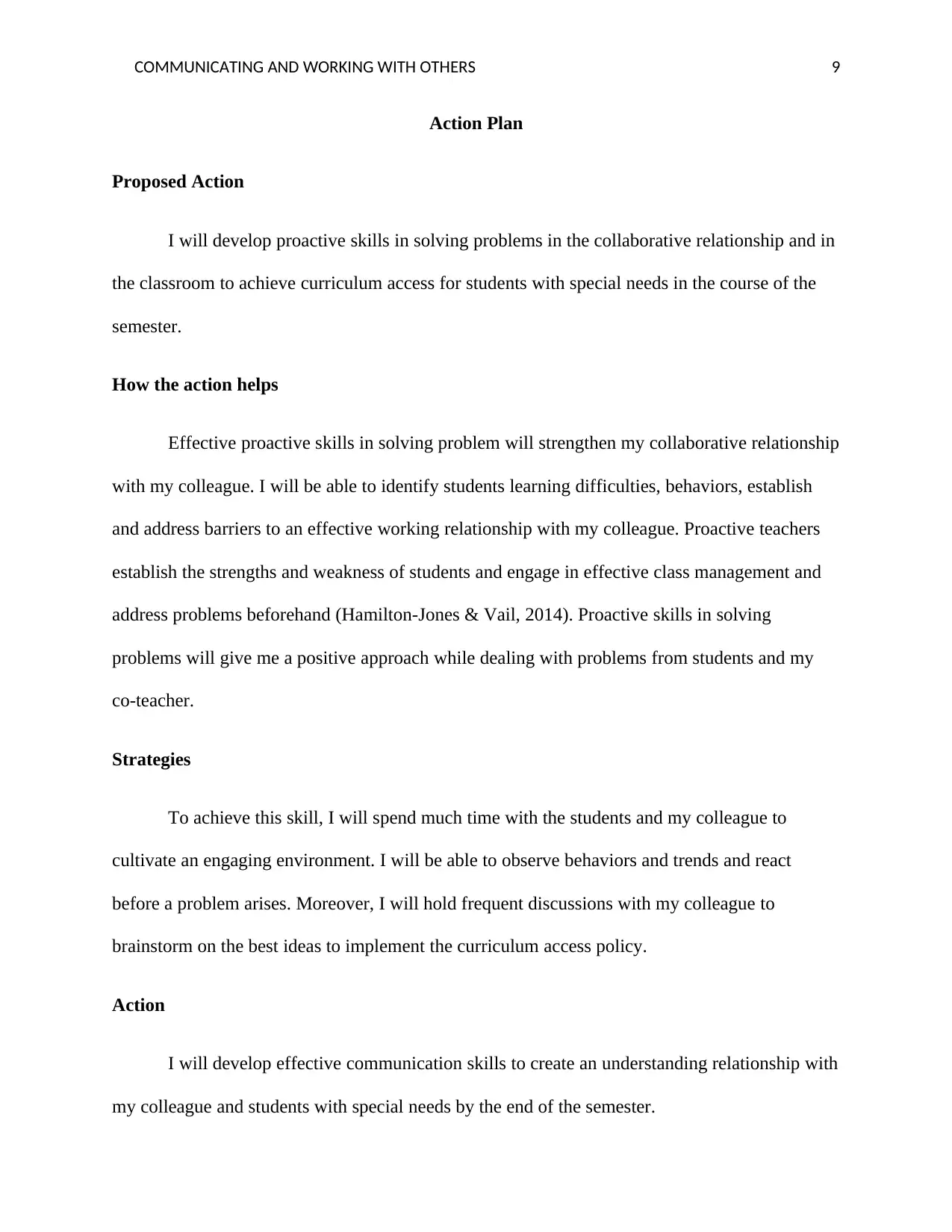
COMMUNICATING AND WORKING WITH OTHERS 9
Action Plan
Proposed Action
I will develop proactive skills in solving problems in the collaborative relationship and in
the classroom to achieve curriculum access for students with special needs in the course of the
semester.
How the action helps
Effective proactive skills in solving problem will strengthen my collaborative relationship
with my colleague. I will be able to identify students learning difficulties, behaviors, establish
and address barriers to an effective working relationship with my colleague. Proactive teachers
establish the strengths and weakness of students and engage in effective class management and
address problems beforehand (Hamilton-Jones & Vail, 2014). Proactive skills in solving
problems will give me a positive approach while dealing with problems from students and my
co-teacher.
Strategies
To achieve this skill, I will spend much time with the students and my colleague to
cultivate an engaging environment. I will be able to observe behaviors and trends and react
before a problem arises. Moreover, I will hold frequent discussions with my colleague to
brainstorm on the best ideas to implement the curriculum access policy.
Action
I will develop effective communication skills to create an understanding relationship with
my colleague and students with special needs by the end of the semester.
Action Plan
Proposed Action
I will develop proactive skills in solving problems in the collaborative relationship and in
the classroom to achieve curriculum access for students with special needs in the course of the
semester.
How the action helps
Effective proactive skills in solving problem will strengthen my collaborative relationship
with my colleague. I will be able to identify students learning difficulties, behaviors, establish
and address barriers to an effective working relationship with my colleague. Proactive teachers
establish the strengths and weakness of students and engage in effective class management and
address problems beforehand (Hamilton-Jones & Vail, 2014). Proactive skills in solving
problems will give me a positive approach while dealing with problems from students and my
co-teacher.
Strategies
To achieve this skill, I will spend much time with the students and my colleague to
cultivate an engaging environment. I will be able to observe behaviors and trends and react
before a problem arises. Moreover, I will hold frequent discussions with my colleague to
brainstorm on the best ideas to implement the curriculum access policy.
Action
I will develop effective communication skills to create an understanding relationship with
my colleague and students with special needs by the end of the semester.
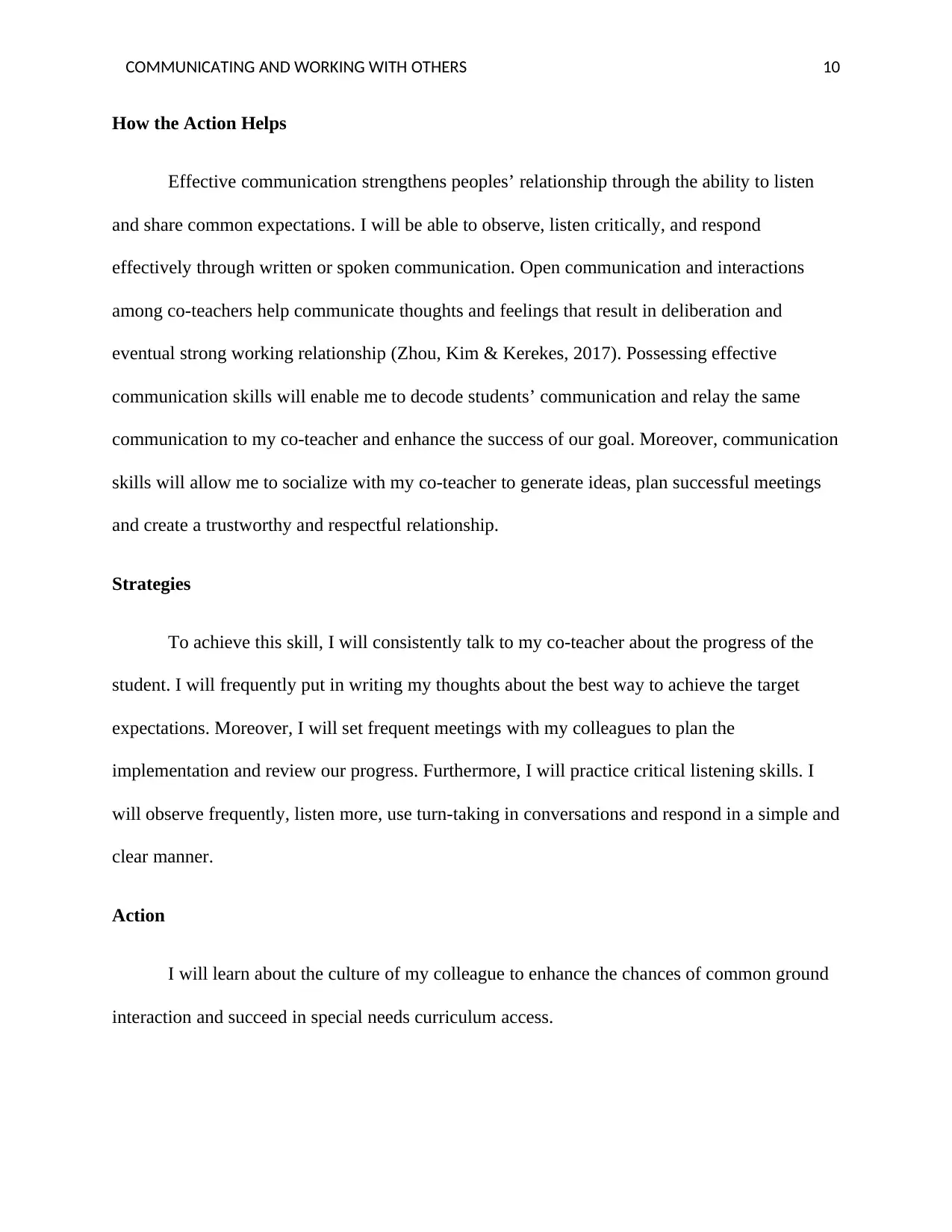
COMMUNICATING AND WORKING WITH OTHERS 10
How the Action Helps
Effective communication strengthens peoples’ relationship through the ability to listen
and share common expectations. I will be able to observe, listen critically, and respond
effectively through written or spoken communication. Open communication and interactions
among co-teachers help communicate thoughts and feelings that result in deliberation and
eventual strong working relationship (Zhou, Kim & Kerekes, 2017). Possessing effective
communication skills will enable me to decode students’ communication and relay the same
communication to my co-teacher and enhance the success of our goal. Moreover, communication
skills will allow me to socialize with my co-teacher to generate ideas, plan successful meetings
and create a trustworthy and respectful relationship.
Strategies
To achieve this skill, I will consistently talk to my co-teacher about the progress of the
student. I will frequently put in writing my thoughts about the best way to achieve the target
expectations. Moreover, I will set frequent meetings with my colleagues to plan the
implementation and review our progress. Furthermore, I will practice critical listening skills. I
will observe frequently, listen more, use turn-taking in conversations and respond in a simple and
clear manner.
Action
I will learn about the culture of my colleague to enhance the chances of common ground
interaction and succeed in special needs curriculum access.
How the Action Helps
Effective communication strengthens peoples’ relationship through the ability to listen
and share common expectations. I will be able to observe, listen critically, and respond
effectively through written or spoken communication. Open communication and interactions
among co-teachers help communicate thoughts and feelings that result in deliberation and
eventual strong working relationship (Zhou, Kim & Kerekes, 2017). Possessing effective
communication skills will enable me to decode students’ communication and relay the same
communication to my co-teacher and enhance the success of our goal. Moreover, communication
skills will allow me to socialize with my co-teacher to generate ideas, plan successful meetings
and create a trustworthy and respectful relationship.
Strategies
To achieve this skill, I will consistently talk to my co-teacher about the progress of the
student. I will frequently put in writing my thoughts about the best way to achieve the target
expectations. Moreover, I will set frequent meetings with my colleagues to plan the
implementation and review our progress. Furthermore, I will practice critical listening skills. I
will observe frequently, listen more, use turn-taking in conversations and respond in a simple and
clear manner.
Action
I will learn about the culture of my colleague to enhance the chances of common ground
interaction and succeed in special needs curriculum access.
Secure Best Marks with AI Grader
Need help grading? Try our AI Grader for instant feedback on your assignments.
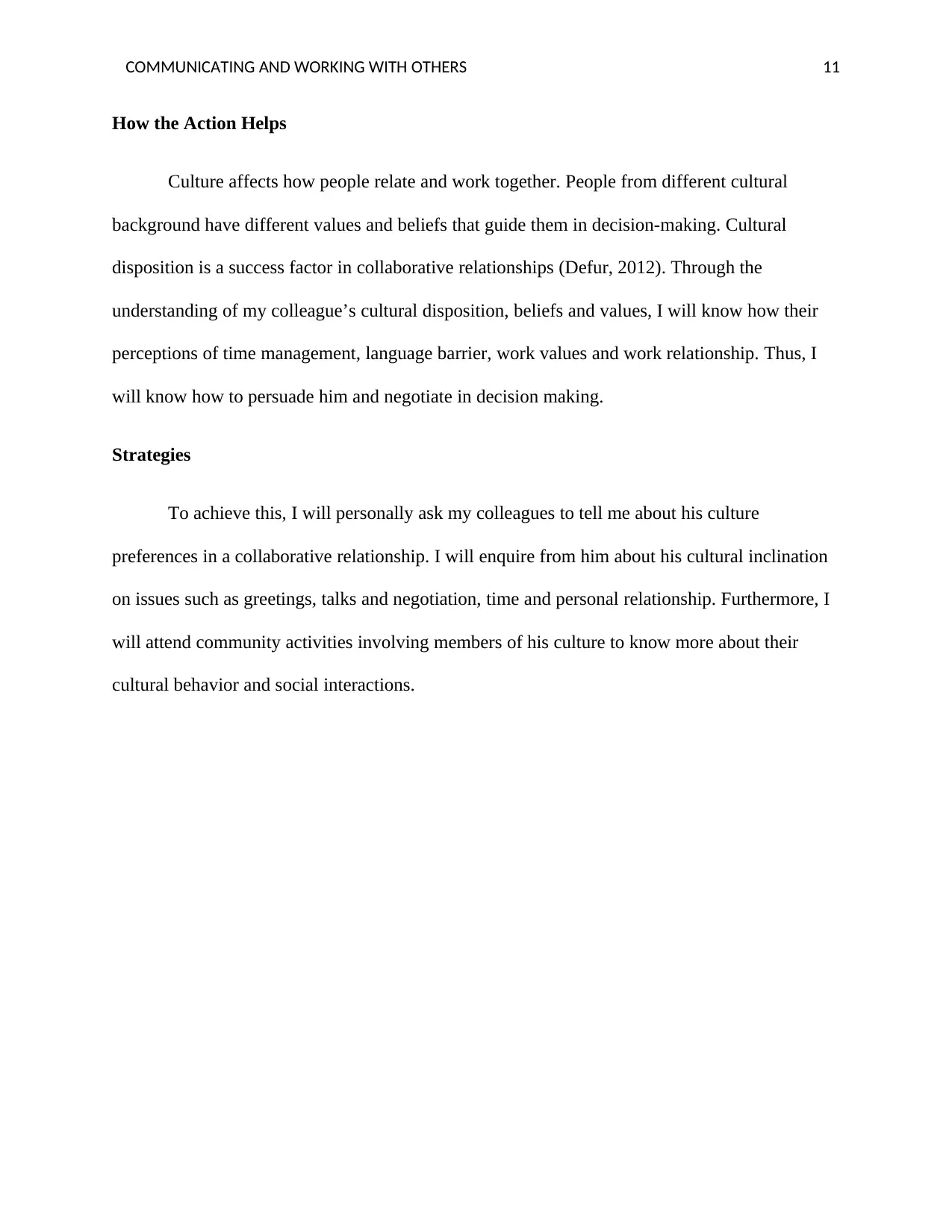
COMMUNICATING AND WORKING WITH OTHERS 11
How the Action Helps
Culture affects how people relate and work together. People from different cultural
background have different values and beliefs that guide them in decision-making. Cultural
disposition is a success factor in collaborative relationships (Defur, 2012). Through the
understanding of my colleague’s cultural disposition, beliefs and values, I will know how their
perceptions of time management, language barrier, work values and work relationship. Thus, I
will know how to persuade him and negotiate in decision making.
Strategies
To achieve this, I will personally ask my colleagues to tell me about his culture
preferences in a collaborative relationship. I will enquire from him about his cultural inclination
on issues such as greetings, talks and negotiation, time and personal relationship. Furthermore, I
will attend community activities involving members of his culture to know more about their
cultural behavior and social interactions.
How the Action Helps
Culture affects how people relate and work together. People from different cultural
background have different values and beliefs that guide them in decision-making. Cultural
disposition is a success factor in collaborative relationships (Defur, 2012). Through the
understanding of my colleague’s cultural disposition, beliefs and values, I will know how their
perceptions of time management, language barrier, work values and work relationship. Thus, I
will know how to persuade him and negotiate in decision making.
Strategies
To achieve this, I will personally ask my colleagues to tell me about his culture
preferences in a collaborative relationship. I will enquire from him about his cultural inclination
on issues such as greetings, talks and negotiation, time and personal relationship. Furthermore, I
will attend community activities involving members of his culture to know more about their
cultural behavior and social interactions.
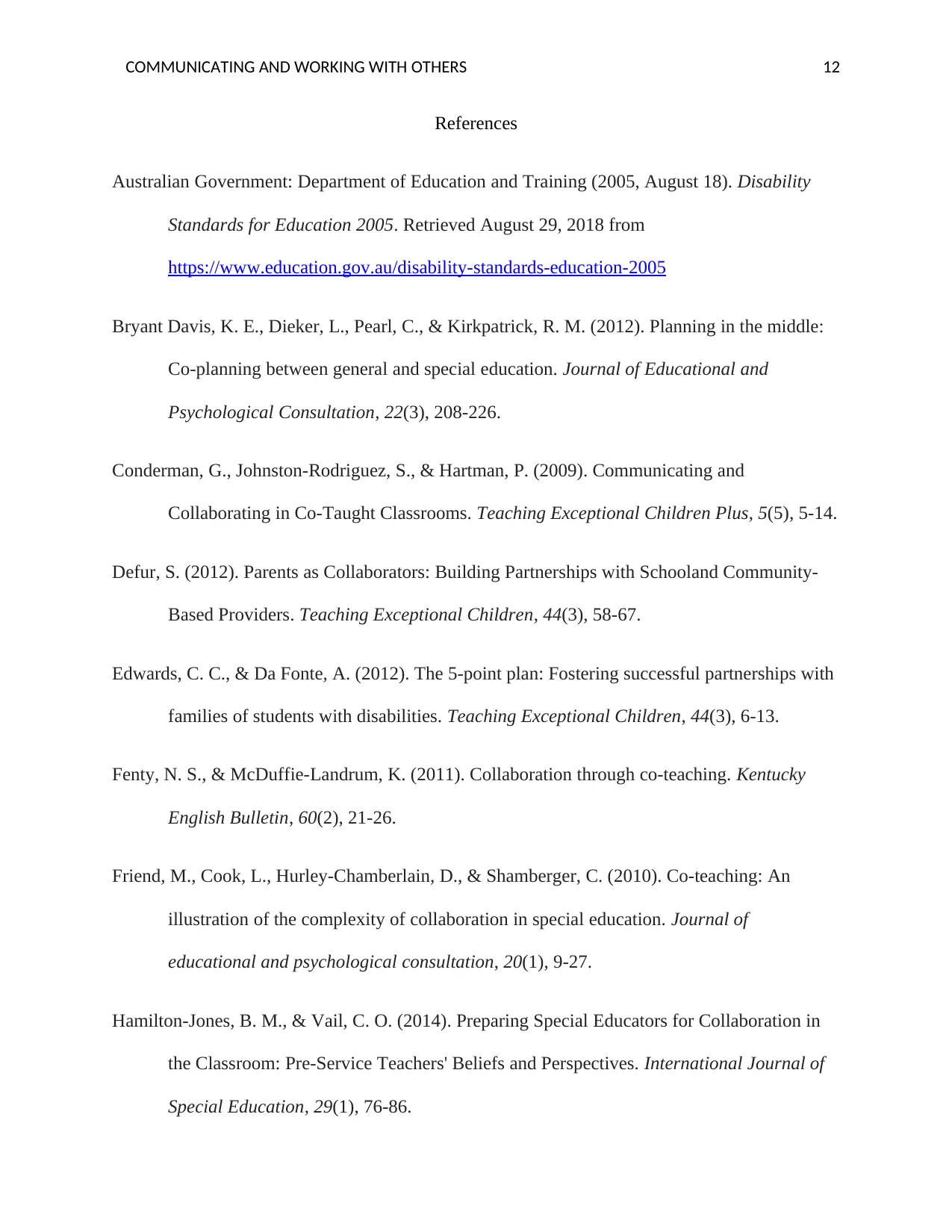
COMMUNICATING AND WORKING WITH OTHERS 12
References
Australian Government: Department of Education and Training (2005, August 18). Disability
Standards for Education 2005. Retrieved August 29, 2018 from
https://www.education.gov.au/disability-standards-education-2005
Bryant Davis, K. E., Dieker, L., Pearl, C., & Kirkpatrick, R. M. (2012). Planning in the middle:
Co-planning between general and special education. Journal of Educational and
Psychological Consultation, 22(3), 208-226.
Conderman, G., Johnston-Rodriguez, S., & Hartman, P. (2009). Communicating and
Collaborating in Co-Taught Classrooms. Teaching Exceptional Children Plus, 5(5), 5-14.
Defur, S. (2012). Parents as Collaborators: Building Partnerships with Schooland Community-
Based Providers. Teaching Exceptional Children, 44(3), 58-67.
Edwards, C. C., & Da Fonte, A. (2012). The 5-point plan: Fostering successful partnerships with
families of students with disabilities. Teaching Exceptional Children, 44(3), 6-13.
Fenty, N. S., & McDuffie-Landrum, K. (2011). Collaboration through co-teaching. Kentucky
English Bulletin, 60(2), 21-26.
Friend, M., Cook, L., Hurley-Chamberlain, D., & Shamberger, C. (2010). Co-teaching: An
illustration of the complexity of collaboration in special education. Journal of
educational and psychological consultation, 20(1), 9-27.
Hamilton-Jones, B. M., & Vail, C. O. (2014). Preparing Special Educators for Collaboration in
the Classroom: Pre-Service Teachers' Beliefs and Perspectives. International Journal of
Special Education, 29(1), 76-86.
References
Australian Government: Department of Education and Training (2005, August 18). Disability
Standards for Education 2005. Retrieved August 29, 2018 from
https://www.education.gov.au/disability-standards-education-2005
Bryant Davis, K. E., Dieker, L., Pearl, C., & Kirkpatrick, R. M. (2012). Planning in the middle:
Co-planning between general and special education. Journal of Educational and
Psychological Consultation, 22(3), 208-226.
Conderman, G., Johnston-Rodriguez, S., & Hartman, P. (2009). Communicating and
Collaborating in Co-Taught Classrooms. Teaching Exceptional Children Plus, 5(5), 5-14.
Defur, S. (2012). Parents as Collaborators: Building Partnerships with Schooland Community-
Based Providers. Teaching Exceptional Children, 44(3), 58-67.
Edwards, C. C., & Da Fonte, A. (2012). The 5-point plan: Fostering successful partnerships with
families of students with disabilities. Teaching Exceptional Children, 44(3), 6-13.
Fenty, N. S., & McDuffie-Landrum, K. (2011). Collaboration through co-teaching. Kentucky
English Bulletin, 60(2), 21-26.
Friend, M., Cook, L., Hurley-Chamberlain, D., & Shamberger, C. (2010). Co-teaching: An
illustration of the complexity of collaboration in special education. Journal of
educational and psychological consultation, 20(1), 9-27.
Hamilton-Jones, B. M., & Vail, C. O. (2014). Preparing Special Educators for Collaboration in
the Classroom: Pre-Service Teachers' Beliefs and Perspectives. International Journal of
Special Education, 29(1), 76-86.
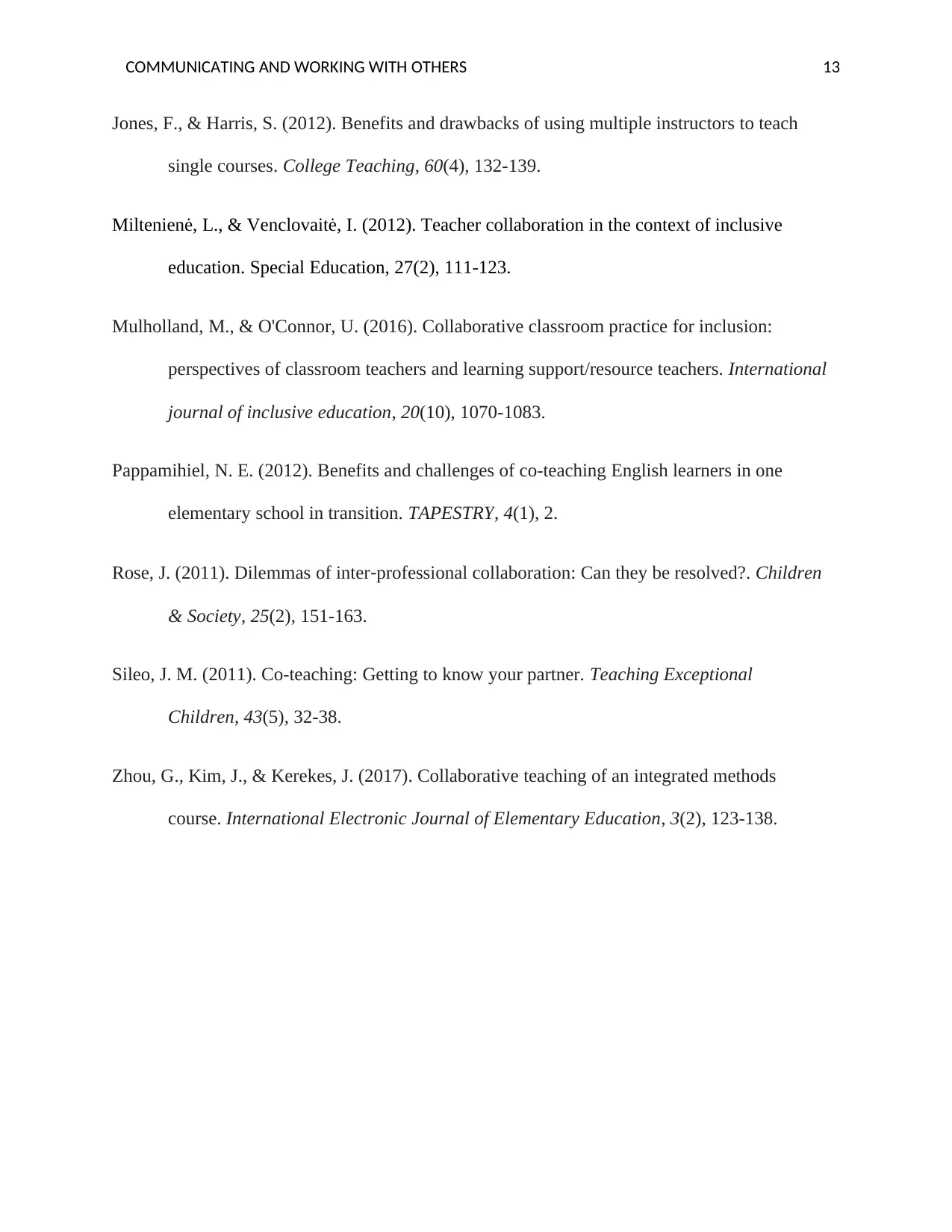
COMMUNICATING AND WORKING WITH OTHERS 13
Jones, F., & Harris, S. (2012). Benefits and drawbacks of using multiple instructors to teach
single courses. College Teaching, 60(4), 132-139.
Miltenienė, L., & Venclovaitė, I. (2012). Teacher collaboration in the context of inclusive
education. Special Education, 27(2), 111-123.
Mulholland, M., & O'Connor, U. (2016). Collaborative classroom practice for inclusion:
perspectives of classroom teachers and learning support/resource teachers. International
journal of inclusive education, 20(10), 1070-1083.
Pappamihiel, N. E. (2012). Benefits and challenges of co-teaching English learners in one
elementary school in transition. TAPESTRY, 4(1), 2.
Rose, J. (2011). Dilemmas of inter‐professional collaboration: Can they be resolved?. Children
& Society, 25(2), 151-163.
Sileo, J. M. (2011). Co-teaching: Getting to know your partner. Teaching Exceptional
Children, 43(5), 32-38.
Zhou, G., Kim, J., & Kerekes, J. (2017). Collaborative teaching of an integrated methods
course. International Electronic Journal of Elementary Education, 3(2), 123-138.
Jones, F., & Harris, S. (2012). Benefits and drawbacks of using multiple instructors to teach
single courses. College Teaching, 60(4), 132-139.
Miltenienė, L., & Venclovaitė, I. (2012). Teacher collaboration in the context of inclusive
education. Special Education, 27(2), 111-123.
Mulholland, M., & O'Connor, U. (2016). Collaborative classroom practice for inclusion:
perspectives of classroom teachers and learning support/resource teachers. International
journal of inclusive education, 20(10), 1070-1083.
Pappamihiel, N. E. (2012). Benefits and challenges of co-teaching English learners in one
elementary school in transition. TAPESTRY, 4(1), 2.
Rose, J. (2011). Dilemmas of inter‐professional collaboration: Can they be resolved?. Children
& Society, 25(2), 151-163.
Sileo, J. M. (2011). Co-teaching: Getting to know your partner. Teaching Exceptional
Children, 43(5), 32-38.
Zhou, G., Kim, J., & Kerekes, J. (2017). Collaborative teaching of an integrated methods
course. International Electronic Journal of Elementary Education, 3(2), 123-138.
Paraphrase This Document
Need a fresh take? Get an instant paraphrase of this document with our AI Paraphraser

COMMUNICATING AND WORKING WITH OTHERS 14
1 out of 14
Related Documents
Your All-in-One AI-Powered Toolkit for Academic Success.
+13062052269
info@desklib.com
Available 24*7 on WhatsApp / Email
![[object Object]](/_next/static/media/star-bottom.7253800d.svg)
Unlock your academic potential
© 2024 | Zucol Services PVT LTD | All rights reserved.




